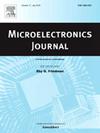Analysis of superjunction structure of fast switching loss IGBT with non-equivalent segmented anode NPN
IF 1.9
3区 工程技术
Q3 ENGINEERING, ELECTRICAL & ELECTRONIC
引用次数: 0
Abstract
To reduce switching losses and improve the breakdown voltage of IGBTs, a novel superjunction IGBT structure with a non-equivalent segmented anode NPN transistor (NSA-SJ-IGBT) is proposed, along with a simulation study of its performance. The proposed structure incorporates a collector region embedded with a non-equivalent segmented anode NPN transistor. By optimizing the concentration and thickness of the P-type region in the NPN transistor of the NSA-SJ-IGBT, electron extraction during the turn-off process is accelerated, resulting in a significant reduction in turn-off losses. Additionally, during the turn-on process, the NSA-SJ-IGBT benefits from a more direct flow path for both electrons and holes, as well as a more uniform distribution of electron and hole densities, which facilitates faster and more efficient turn-on. Compared to the NSA-BJSJ-IGBT structure, the NSA-SJ-IGBT exhibits a reduction of approximately 38.7 % in turn-on losses at the same forward conduction voltage, while maintaining similar breakdown voltage and turn-off losses. When compared to the BJSJ-IGBT, under equivalent conditions and comparable forward conduction voltage, the NSA-SJ-IGBT demonstrates a 41 % reduction in turn-off losses, a 32 % reduction in turn-on losses, and an improvement in breakdown voltage. Furthermore, the NSA-SJ-IGBT offers significant design flexibility, enabling better optimization of the trade-off between turn-off loss and conduction voltage drop by adjusting the embedded NPN transistor, thereby enhancing overall device performance.
非等效分段负极NPN快速开关损耗IGBT超结结构分析
为了降低IGBT的开关损耗,提高其击穿电压,提出了一种新型的非等效分段阳极NPN晶体管超结IGBT结构(NSA-SJ-IGBT),并对其性能进行了仿真研究。所提出的结构包含嵌入非等效分段阳极NPN晶体管的集电极区域。通过优化NSA-SJ-IGBT NPN晶体管中p型区的浓度和厚度,加速了关断过程中的电子提取,从而显著降低了关断损耗。此外,在导通过程中,NSA-SJ-IGBT受益于电子和空穴更直接的流动路径,以及更均匀的电子和空穴密度分布,从而促进更快,更有效的导通。与NSA-BJSJ-IGBT结构相比,NSA-SJ-IGBT结构在相同正向导通电压下的导通损耗降低了约38.7%,同时保持了相似的击穿电压和关断损耗。与BJSJ-IGBT相比,在等效条件和相当的正向导通电压下,NSA-SJ-IGBT的关断损耗降低41%,导通损耗降低32%,击穿电压提高。此外,NSA-SJ-IGBT提供了显著的设计灵活性,通过调整嵌入式NPN晶体管,可以更好地优化关断损耗和导通压降之间的权衡,从而提高整体器件性能。
本文章由计算机程序翻译,如有差异,请以英文原文为准。
求助全文
约1分钟内获得全文
求助全文
来源期刊

Microelectronics Journal
工程技术-工程:电子与电气
CiteScore
4.00
自引率
27.30%
发文量
222
审稿时长
43 days
期刊介绍:
Published since 1969, the Microelectronics Journal is an international forum for the dissemination of research and applications of microelectronic systems, circuits, and emerging technologies. Papers published in the Microelectronics Journal have undergone peer review to ensure originality, relevance, and timeliness. The journal thus provides a worldwide, regular, and comprehensive update on microelectronic circuits and systems.
The Microelectronics Journal invites papers describing significant research and applications in all of the areas listed below. Comprehensive review/survey papers covering recent developments will also be considered. The Microelectronics Journal covers circuits and systems. This topic includes but is not limited to: Analog, digital, mixed, and RF circuits and related design methodologies; Logic, architectural, and system level synthesis; Testing, design for testability, built-in self-test; Area, power, and thermal analysis and design; Mixed-domain simulation and design; Embedded systems; Non-von Neumann computing and related technologies and circuits; Design and test of high complexity systems integration; SoC, NoC, SIP, and NIP design and test; 3-D integration design and analysis; Emerging device technologies and circuits, such as FinFETs, SETs, spintronics, SFQ, MTJ, etc.
Application aspects such as signal and image processing including circuits for cryptography, sensors, and actuators including sensor networks, reliability and quality issues, and economic models are also welcome.
 求助内容:
求助内容: 应助结果提醒方式:
应助结果提醒方式:


